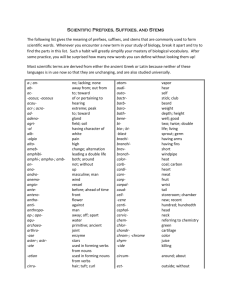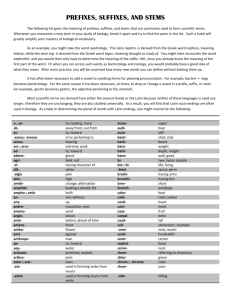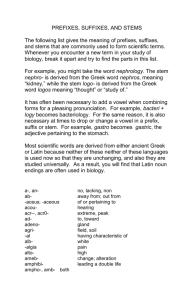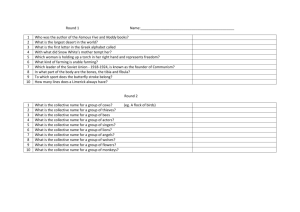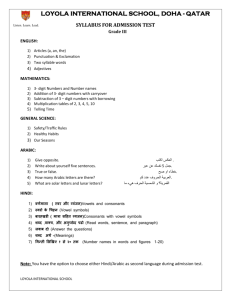Document 10466682
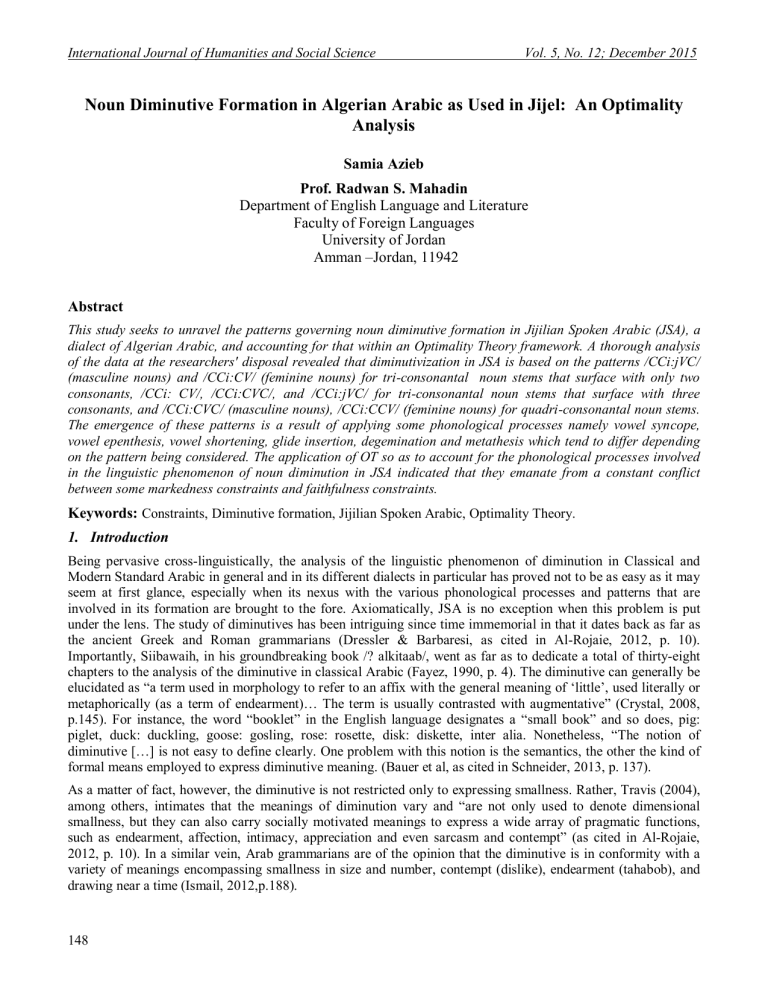
International Journal of Humanities and Social Science Vol. 5, No. 12; December 2015
Noun Diminutive Formation in Algerian Arabic as Used in Jijel: An Optimality
Analysis
Samia Azieb
Prof. Radwan S. Mahadin
Department of English Language and Literature
Faculty of Foreign Languages
University of Jordan
Amman –Jordan, 11942
Abstract
This study seeks to unravel the patterns governing noun diminutive formation in Jijilian Spoken Arabic (JSA), a dialect of Algerian Arabic, and accounting for that within an Optimality Theory framework. A thorough analysis of the data at the researchers' disposal revealed that diminutivization in JSA is based on the patterns /CCi:jVC/
(masculine nouns) and /CCi:CV/ (feminine nouns) for tri-consonantal noun stems that surface with only two consonants, /CCi: CV/, /CCi:CVC/, and /CCi:jVC/ for tri-consonantal noun stems that surface with three consonants, and /CCi:CVC/ (masculine nouns), /CCi:CCV/ (feminine nouns) for quadri-consonantal noun stems.
The emergence of these patterns is a result of applying some phonological processes namely vowel syncope, vowel epenthesis, vowel shortening, glide insertion, degemination and metathesis which tend to differ depending on the pattern being considered. The application of OT so as to account for the phonological processes involved in the linguistic phenomenon of noun diminution in JSA indicated that they emanate from a constant conflict between some markedness constraints and faithfulness constraints.
Keywords:
Constraints, Diminutive formation, Jijilian Spoken Arabic, Optimality Theory.
1.
Introduction
Being pervasive cross-linguistically, the analysis of the linguistic phenomenon of diminution in Classical and
Modern Standard Arabic in general and in its different dialects in particular has proved not to be as easy as it may seem at first glance, especially when its nexus with the various phonological processes and patterns that are involved in its formation are brought to the fore. Axiomatically, JSA is no exception when this problem is put under the lens. The study of diminutives has been intriguing since time immemorial in that it dates back as far as the ancient Greek and Roman grammarians (Dressler & Barbaresi, as cited in Al-Rojaie, 2012, p. 10).
Importantly, Siibawaih, in his groundbreaking book /? alkitaab/, went as far as to dedicate a total of thirty-eight chapters to the analysis of the diminutive in classical Arabic (Fayez, 1990, p. 4). The diminutive can generally be elucidated as “a term used in morphology to refer to an affix with the general meaning of ‘little’, used literally or metaphorically (as a term of endearment)… The term is usually contrasted with augmentative” (Crystal, 2008, p.145). For instance, the word “booklet” in the English language designates a “small book” and so does, pig: piglet, duck: duckling, goose: gosling, rose: rosette, disk: diskette, inter alia. Nonetheless, “The notion of diminutive […] is not easy to define clearly. One problem with this notion is the semantics, the other the kind of formal means employed to express diminutive meaning. (Bauer et al, as cited in Schneider, 2013, p. 137).
As a matter of fact, however, the diminutive is not restricted only to expressing smallness. Rather, Travis (2004), among others, intimates that the meanings of diminution vary and “are not only used to denote dimensional smallness, but they can also carry socially motivated meanings to express a wide array of pragmatic functions, such as endearment, affection, intimacy, appreciation and even sarcasm and contempt” (as cited in Al-Rojaie,
2012, p. 10). In a similar vein, Arab grammarians are of the opinion that the diminutive is in conformity with a variety of meanings encompassing smallness in size and number, contempt (dislike), endearment (tahabob), and drawing near a time (Ismail, 2012,p.188).
148
ISSN 2220-8488 (Print), 2221-0989 (Online) ©Center for Promoting Ideas, USA www.ijhssnet.com
Intriguingly, “the diminutive is also considered a type of derivation and it has a sub-type called diminutive elision, which is used mostly for courtship and poetic necessities” (Ibrahim, 2010, p.615). Though a great number of languages have at their disposal the diminutive forms, considerable cross linguistic variation in their formation does exist. To instantiate, Finnish diminutives can stem from either normal affixation or other extra means like shortening the original stem and attaching an affix-like element, e.g. porsas: possu, silmä: simmu and käsi: känny
(Laalo, 2001, p. 71). As for English, for example, most diminutive forms are shaped by dint of suffixation: - ette, - et, let, etc. to a noun. (Hamid & Faiq, 2009, p. 2). Yet, prefixation is also possible. Conversely, Classical Arabic utilizes three major patterns for the diminutive which were propounded by Siibawaih viz: /fu ʕ ayl/, /fu ʕ ay ʕ il/, and
/fu ʕ ay ʕ iil/ and their use is inextricably linked to the number of consonants in the basic form (Fayez, 1990, p. 27).
At this juncture, it is worth mentioning that diminutive formation in JSA could be explained under the banner of the Optimality Theory.
In a nutshell, OT was spearheaded by its originators Alan Prince and Paul Smolensky in 1991 (McCarthy, 2002, p. 1). Particularly, it had its onset at the University of Arizona Phonology Conference in Tucson as an offshoot of the introduced paper “Optimality” by the aforementioned prominent figures (Archangeli, 1997, p.1). It was something of a watershed in linguistics in general and in phonology in particular. OT boomed and had a colossal impact on the field of phonology. Basically, it revolves around the idea that Universal Grammar furnishes us with a set of highly general constraints (Prince& Smolensky, 2004, p.4). These constraints are universal and violable and they are divided into two facets: Markedness Constraints and Faithfulness Constraints. The former are concerned with the well-formedness of the output while the latter require the output of the grammar to be identical to its input. OT constraints (CON) are in a constant conflict that could only be resolved via ranking them
(McCarthy, 2007, p.5). In addition to CON, OT grammar subsumes other components namely: the lexicon or input, the generator ( GEN) which generates output candidates for that input, and the evaluator (EVAL) whose function is to identify the optimal output or the most harmonic one among the set of competing, language-specific ranked constraints (Kager, 1999, p.19).
1.
Literature Review
Diminutive formation in an array of languages has been approached by different researchers either with an OT analysis or by dint of other approaches. Unluckily, however, diminutivization both in Standard Arabic and dialectal Arabic has not received ample attention in the literature especially within the framework of OT.
Therefore, it could be stated that this is an area that is characterized by the paucity of research in it. Rashid (2010) attempted an investigation of the diminutive forms in Modern Standard Arabic in the light of the Optimality
Theory. In doing so, she focused on the diminutive forms of three-consonantal, four-consonantal and fiveconsonantal nouns. She found out that there is a frequent violation of the markedness constraint (Cod) which reflects the existence of closed syllables in Arabic diminutive forms. This is coupled with the absence of violations for the markedness constraints Ons and Nuc and some faithfulness constraints such as Fill
Ons
, Fill
Nuc and Parse. In accord with this, onsetless syllables, syllables lacking nuclei and deformed syllables that witness delition of some segments are absent in MSA diminutive forms.
Following similar lines of inquiry, Ismail (2012) conducted a study on the diminutive in Modern Standard Arabic and tackled it from an OT perspective. To this end, he did not consider Arabic diminutive derivation as a mere mapping of root consonants onto well-defined positions of a diminutive pattern. Rather, he viewed it as a question of conflicting preferences. Particularly, he employed the Correspondence Theory which was developed within the framework of OT so that, for instance, the optimal output for [kalb] is ku .
lajb because it violates a lower ranked constraint: DEP-BO: Every element in the output has a correspondent in the base. Diminutivization in other languages was also approached from an OT perspective. For instance, Weijer (2002) analysed the Dutch diminutive within the framework of the OT. Accordingly, the researcher presented the outlines of an OT-style analysis of the allomorphy in the standard language, and compared it to earlier rule-based work so as to show how the latter failed to capture a number of phonological regularities. The researcher concluded that the alternations induced by the Dutch diminutive seem amenable to an OT-style treatment, with natural, general constraints taking the place of morpheme-specific rules.
In a seminal study, Cheng (2013) set light on the retroflex diminutives in the Nanjing dialect (China) and framed it in terms of OT. In a nutshell, the formation of retroflex diminutives in the Nanjing dialect can be captured by a set of ranked constraints namely: MAX[r], ANCHOR-SD (L), ANCHOR-r(R), *r/?, *r/N, *r/ VH/F >>
CONTIGTY-Final σ -IO, OKFinal, ONS [palatal]V[H,F] >> MAX-SD, DEP-SD, IDENT-SD[r].
149
International Journal of Humanities and Social Science Vol. 5, No. 12; December 2015
Likewise, Lee (2014) inquired into the phonological processes in Xitsonga diminutives, a southern African Bantu language spoken by the Tsonga people and tried to account for them from a constraint-based perspective (OT).
In accordance with this, three phonological processes are identified namely: glide formation, velarisation and vowel deletion, all of which are thought of as repair strategies that apply in order to avoid a sequence of labial sounds.
Interestingly, the avoidance of the latter emanates from a conflict between some faithfulness constraints and markedness ones such as MAX-V [LAB] (Assign a violation mark when a round vowel ([labial]) in the input does not have a correspondent in the output) and OCP-LABIAL (Assign a violation mark to labials that are adjacent) respectively. As is clear, the linguistic phenomenon of diminution in different Arabic dialects has received scant attention in the literature. Accordingly, and after reviewing the literature, it has become apparent that diminutive formation in Jijilian Spoken Arabic (JSA), a dialect of Algerian Arabic, was not subject to previous research neither in the light of an Optimality model nor within the framework of other phonological theories. Therefore, the present research work aims at filling the gap by using the OT with the hope of accounting for the phonological processes that help in noun diminutive derivation in JSA.
3.
Methodology
The primary informant of the data is the first author who is a native speaker of the variety under scrutiny: Jijilian
Spoken Arabic, a dialect of Algerian Arabic. However, this was also supplemented by consulting several other native- speaker respondents who gave a hand by providing more examples of the diminutive forms and helping in the adjustment of the transcription of both the basic forms and the diminutive ones. Importantly, the phonological differences that relate to some variables including gender, age and the like were overlooked in the present study.
4.
Results and Discussion
The findings of the study are presented and discussed in two sub-sections depending on the number of consonants in the stems of the nouns viz: (1) The Diminutive Formation for Tri-consonantal Noun Stems in JSA, and (2) The
Diminutive Formation for Quadri-consonantal Noun Stems in JSA.
4.1. The Diminutive Formation for Tri-consonantal Noun Stems in JSA
A close examination of the data postulates that tri-consonantal nouns in JSA are of two types namely: those which have only two consonants at the surface and those that have three consonants both in the underlying and the surface representations. These are going to be laid out in what follows.
4.1.1. Nouns Surfacing as Bi-consonantal
The analysis of the diminutive forms for tri-consonantal nouns that surface as bi-consonantal results in identifying two diminutives forms which surface as follows: the /CCi: CV/ pattern for feminine nouns in the Jijilian dialect and the /CCi: jVC/ pattern for masculine ones. These surface patterns are a result of some phonological processes that can be accounted for in terms of the interaction between such markedness constraints and faithfulness constraints.
4.1.1.1. Feminine Nouns’ Diminutives: The /CCi:CV/ Pattern
The underlying assumption in the present research work is that /i:/ insertion is treated as an important indicator for diminutives in JSA. The following examples illustrate the derivation of feminine nouns’ diminutives by identifying two phonological processes: vowel syncope, and glide/vowel epenthesis.
(1) Base
sa: ʕ a ṭ a:qa
Diminutive swi: ʕ a ṭ wiqa
Gloss
‘one hour’ ħu:ta ʒ a: ʒ a ħwi:ta ʒ wi: ʒ a
‘a window’
‘a fish’
‘a chicken’
So, as it is plainly displayed in the examples in (1), the vowel which constitutes the nucleus of the first syllable like in /sa: ʕ a/ is deleted in the diminutive forms. Therefore, it violates the faithfulness constraint of MAX-V-IO which states that “Input vowels must have output correspondents” (no vowel deletion). Such vowel underparsing is motivated by the need for the glide /w/ insertion which is necessary to satisfy the requirement that the first syllable in all of the diminutives in JSA must be bi-consonantal.
150
ISSN 2220-8488 (Print), 2221-0989 (Online) ©Center for Promoting Ideas, USA www.ijhssnet.com
At this juncture, it is worth noting that the reason why it is /w/ that is inserted and not another segment is because it is part of the underlying forms of these words and is deleted as a result of a glide elision rule, that is /w/ is deleted when “it occurs between two a-grade vowels, i.e. awa becomes aa” (Brame, 1970, p.30) Thus, it surfaces in the diminutive forms to satisfy the requirement of having bi-consonantal onsets. In this regard, Al-khalil (as cited in Mahadin, 1982, p.91) states that "words do occur formed from two letters (phonemes), whereas their complete form and their significance is tri-consonantal, the third letter (phoneme) is gone because of its weakness". Intriguingly, one is inclined to simply think that bi-consonantal nouns do have a glide in the underlying form which tends to surface in some derived forms of these nouns like in diminutives ( Mahadin,
1982, p.102). In symbiosis with this, such an insertion violates the anti-epenthesis faithfulness constraint DEP-IO which necessitates that “every segment of the output has a correspondent in the input, (Prohibits phonological epenthesis)” (McCarthy & Prince, 1995.p. 16). However, there is a markedness constraint which prohibits complex onsets of all types: *Complex ONS . Therefore, it could be parameterized so as to meet the needs of the dialect under scrutiny (Al-Mohanna, as cited in Benyoucef & Mahadin, 2013, p. 7):
(2) *Complex ONS C (CC): onsets must be bi-consonantal (mono-consonantal and tri-consonantal onsets are prohibited)
In addition, the vowel /i: / is inserted in all of the forms because it is prerequisite for diminutive formation in
JSA. Hence, it incurs a violation of DEP-IO (no epenthesis). Therefore, the markedness constraint *Complex
ONS C (CC) dominates both faithfulness constraints: MAX-V-IO and DEP-IO.
A synopsis of the foregoing discussion is encapsulated in the constraint hierarchy in (3) and in Tableau 1 which both demonstrate why
[ ħwi:ta] is the optimal diminutive output for /ħu:ta/:
(3) *Complex ONS C (CC) >> MAX-V-IO >> DEP-IO. ħu:ta a. ħu:ta b.? ħwi:ta c. ☞ ħwi:ta
*Complex ONS C(CC)
*!
*!
MAX-V-IO
*
DEP-IO
**
** *
Tableau1: The Optimal Output for / ħu:ta/
Tableau1 shows that candidate (c) is the most harmonious or optimal one (pointed at by the index) since it incurs the least costly violations of constraints, that is, violating only the two lower ranked constraints MAX-V-IO and
DEP-IO. (a) is excluded because it violates the higher ranked constraint *Complex ONS C(CC) by including only one consonant in the onset. Likewise, (b) is rejected because it violates the higher ranked constraint *Complex
ONS C(CC) by including the impermissible tri-consonantal onset /?
ħw/ as well as the violation of MAX -V-IO and DEP-IO by lacking the input segment /u:/ and inserting the segments /?/, /w/, and /i:/ respectively. Obviously,
“domination is strict…no possible degree of satisfaction of lower-ranked constraints can compensate for the violation of a single high-ranked constraint” (Kager, 1999, p.23).
4.1.1.2. Masculine Nouns’ Diminutives: The /CCi: jVC/ Pattern
The derivation of diminutives for masculine nouns follows the pattern /CCi: jVC/ and is characterized by the use of almost the same phonological processes and constraints as the pattern for feminine nouns with some additions.
The following data are a case in point:
(4) Base
Sa:k
Ka:s
bi:t
mu:s
Diminutive swi:jak kwi:jas bwi:jat mwi:jas
Gloss
‘a bag’
‘a glass’
‘a room’
‘a knife’
What is new in this pattern (in addition to the aforementioned phonological processes associated with the previous pattern) is the insertion of the vowel /a/ as part of diminutive formation for monosyllabic words which, apparently, need to surface as disyllabic in the diminutive, hence violating the faithfulness constraint DEP-IO which militates against epenthesis. In addition, the glide /j/ is inserted between /i:/ and /a/ in order to satisfy the markedness constraint ONSET which suggests that “syllables must have onsets” (Kager, 1999, p. 93). Also, glide insertion here is a repair strategy to avoid vowel hiatus which is formulated in the markedness constraint NO
HIATUS . Therefore, ONSET and NO HIATUS are left unranked with regard to each other in JSA.
151
International Journal of Humanities and Social Science Vol. 5, No. 12; December 2015
The constraint hierarchy for the phonological processes involved in deriving masculine nouns’ diminutive patterns namely: vowel syncope/epenthesis and glide insertion is as follows:
(5) *Complex ONS C(CC) >> ONSET, NO HIATUS >> MAX-V-IO >> DEP-IO.
ka:s a. ka:s b.?kwi:as c.
☞ kwi:jas
*Complex ONS
C(CC)
*!
*!
ONSET
*!
NO HIATUS
*!
MAX-V-IO
*!
*
DEP-IO
*!
*
Tableau2: The Optimal Output for / ka:s/
Tableau 2 demonstrates that the markedness constraints *Complex ONS C(CC), ONSET, and NO HIATUS outrank the faithfulness constraints MAX-V-IO and DEP-IO. This is the reason why (c) is the winning candidate in the sense that it violates only the two lower-ranked constraints by lacking some input segment and inserting some other segments in the output. (a) and (b) are mercilessly excluded from the competition because they incur fatal violations of the higher ranked constraints, with (b) violating the lower ranked ones as well.
4.1.2. Nouns Surfacing as Tri-consonantal
According to the results of the study, the tri-consonantal noun stems which belong to this category derive their diminutive forms by reliance on one of the following patterns namely: /CCi: CV/, /CCi:CVC/, and /CCi: jVC/ with no distinction between patterns for feminine or masculine nouns.
4.1.2.1. Diminutive Forms with the /CCi: CV/ Pattern
The diminutive of tri-consonantal noun stems belonging to this category is in compliance with the /CCi: CV/ pattern, as is the case with feminine tri-consonantal noun stems that surface as bi-consonantal in JSA. The only difference between the two is in /w/ epenthesis in that it is not inserted in the case under consideration because it is not present in the underlying representation of the nouns. Consider the data in (6):
(6) Base
Xabza ħalwa ṭ absi
karsi ṭ
Diminutive
Xbi:za ħli:wa bi:si kri:si
Gloss
‘bread’
‘a sweet’
‘a dish’
‘a chair’
Consequently, the constraint hierarchy for the phonological processes involved in deriving diminutives for the present type of tri-consonantal noun stems with the pattern /CCi: CV/ namely: vowel syncope and vowel epenthesis is indicated below:
(7) *Complex ONS C(CC) >> MAX-V-IO >> DEP-IO.
NB : for more details, similar analysis is provided in 4.1.1
4.1.2.2. Diminutive Forms with the /CCi: CVC/ Pattern
Another pattern of diminutive formation for tri-consonantal noun stems is /CCi: CVC/. Such a pattern emanates from the application of three main phonological processes namely: vowel syncope, glide and vowel insertion, and vowel shortening in unstressed syllables like in /sabu:n/. The following examples clarify the point:
(8) Base
ra: ʒ al
sabu:n ħanu:t
Diminutive rwi: ʒ al swi:ban ħwi:nat
Gloss
‘a man’
‘a bar of soap’
‘a shop’
To put it in optimality terms, four constraints are in order here. First, the markedness constraint *Complex ONS
C(CC) is higher ranked in JSA and it is satisfied by both vowel deletion (violates MAX-V-IO) and glide insertion
(violates DEP-IO ). The latter is also violated by inserting the vowel /i:/ which is pivotal for diminutivization in
JSA. The fourth constraint that is violated by vowel shortening is IDENT–IO (F): Output correspondents of an input [γF] segment are also [γF], that is, the features of segments in the input should be kept in the output as well.
The constraint ranking in (9) accounts for these phonological processes:
(9) *Complex ONS C(CC) >> MAX-V-IO >> IDENT–IO (F) >> DEP-IO.
152
ISSN 2220-8488 (Print), 2221-0989 (Online) ©Center for Promoting Ideas, USA www.ijhssnet.com sabu:n a. sabu:n b.
☞ swi:ban c.?swi:bu:n
Tableau 3 shows why /swi:ban/ is the optimal output of /sabu:n/
*Complex ONS
C(CC)
*!
*!
MAX-V-IO
*
*!
IDENT–IO (F)
*
DEP-IO
*
*
Tableau3: The Optimal Output for /sabu:n/
Candidate (b) in tableau 3 is the winning one because it is the only candidate which does not violate the higher ranked constraint *Complex ONS C(CC). Candidates (a) and (c) are eliminated from consideration due to their fatal violation of the undominated constraint *Complex ONS C(CC), with (c) having additional violations: MAX-
V-IO and DEP-IO.
Despite the fact that the optimal candidate has more violations than (a), the latter is eliminated while the former is not because lower ranked constraints cannot team against a top ranked one.
4.1.2.3. Diminutive Forms with the /CCi: jVC/ Pattern:
The analysis of data at hand is akin to 4.1.1.2. (Masculine Nouns’ Diminutives: The /CCi: jVC/ Pattern) except for not having /w/ insertion and not having vowel deletion in the words that already begin with CC like /s ħan/.
Thus, one is inclined to think that *Complex ONS C(CC) is still the highest ranked constraint in JSA’s diminutives. Consider the following instances with their corresponding constraint hierarchy:
(10) Base
s ħ an
qalb
kalb
farX
Diminutive s ħi:jan qli:jab kli:jab fri:jaX
Gloss
‘a dish’
‘a heart’
‘a dog’ a bird
(11) *Complex ONS C(CC) >> ONSET, NO HIATUS >> MAX-V-IO >> DEP-IO.
NB : the reader is referred back to 4.1.1.2 for a detailed analysis.
4.2. The Diminutive Formation for Quadri-consonantal Noun Stems
Data analysis of the diminutive forms for Quadri-consonantal noun stems reveals that such a derivation is directed by two main patterns viz: /CCi:CVC/ and /CCi:CCV/ for masculine and feminine nouns respectively.
4.2.1. Masculine Nouns’ Diminutives: The /CCi: CVC/ Pattern
The following examples in (12) illustrate the derivation of masculine nouns’ diminutives which results in the identification of four phonological processes namely: vowel syncope, vowel epenthesis, degemination and vowel shortening.
(12) Base
fallu:s
kurra:s
sabba:t
Diminutive fli:las kri:ras sbi:bat
Gloss
‘a chick’
‘a copybook’
‘a shoe’
As it is plainly displayed in (12), the peak of the first syllable like in / fallu:s / is deleted in the diminutive.
Therefore, it violates the faithfulness constraint MAX-V-IO which requires vowel input segments to have output correspondents (no deletion). This deletion is necessary so as to satisfy the requirement of initial CC in JSA, i.e. the higher-ranked markedness constraint *Complex ONS C(CC). In addition, vowel epenthesis (/i:/) takes place because this vowel is part of diminutive formation for masculine nouns in JSA. Consequently, the DEP-IO faithfulness constraint is violated (no Insertion). This vowel insertion between geminate consonants such as
/kurra:s/ :/ kri:ras/ leads to the violation of another faithfulness constraint, the so-called IDENT-IO[
GEM
]: output correspondent of an input [gem] are also [gem]. This is coupled with the long vowels in the second syllables of the base forms becoming short because those syllables are not stressed in the diminutive. Again faithfulness is at risk: violation of IDENT-IO (F). Given that the violation of MAX-V-IO, DEP-IO, and IDENT-IO[
GEM
] is motivated by the need to satisfy the high ranked constraint *Complex ONS C(CC), these three constraints are left unranked with regard to each other in JSA, just as it is shown in (13) and in tableau 4 :
153
International Journal of Humanities and Social Science Vol. 5, No. 12; December 2015
(13) *Complex ONS C(CC) >> MAX-V-IO, DEP-IO, IDENT-IO [
GEM
] >>IDENT-IO (F) fallu:s a. fallu:s
*Complex ONS
C(CC)
*!
MAX-V-IO
DEP-IO
IDENT-IO[
GEM
] IDENT–IO (F) b.fllu:s c.
☞ fli:las
*! *
* * * *
Tableau4. The Optimal Output for / fallu:s /
Note that in tableau 4, candidate (c) is the optimal one since it is the only constraint which does not violate the higher ranked constraint *Complex ONS C(CC). As for candidates (a) and (b), they are excluded from their competition for optimality simply because they incur a fatal violation of the highest ranked constraint in the constraint hierarchy for the pattern being discussed.
4.2.2. Feminine Nouns’ Diminutives: The /CCi: CCV/ Pattern
Another type of diminutive quadri-consonantal noun stems are those whose pattern of formation is /CCi: CCV/.
Let us consider the examples in (14):
(14) Base
ba ʃ ma:qa ṭ arba:qa
kar ṭ a :ba
sarbi:Ta
marmi:Ta ṭ
Diminutive b ʃ i:mqa ri:bqa kri: ṭ ba sri:bTa mri:mTa
Gloss
‘a type of shoes’
‘a flip-flop’
‘a school bag’
‘a towel’
‘a cooker’
Under the banner of this pattern, the competition between markedness and faithfulness constraints is still relentless. This competition is mirrored in the following phonological processes: Vowel deletion (/a/ and /a:/) so as to help satisfying the markedness constraint *Complex ONS C(CC) . This is done at the expense of the faithfulness constraint MAX-V-IO (no Deletion). In addition, there is vowel insertion: /i:/ which violates DEP-
IO. The constraint hierarchy is as follows:
(15) *Complex ONS C(CC) >> DEP-IO>> MAX-V-IO.
As for the words /sarbi:Ta/ and /marmi:Ta/, they witness vowel deletion: /a/ (violation of MAX-V-IO), and metathesis between the vowel /i:/ and the consonant, both of which aim at satisfying *Complex ONS CCC because if metathesis is not there, erroneous diminutive forms like /sarbi:Ta/ will be inevitable. Therefore, the faithfulness constraint LINEARITY-IO which militates against metathesis is required: “the output reflects the precedence structure of the input and vice versa” (Kager, 1999, p. 63). And since both MAX-V-IO and
LINEARITY-IO lead to satisfying *Complex ONS C(CC), they are left unranked with regard to each other in
JSA. The correspondent constraint hierarchy is indicated in (16):
(16) *Complex ONS C(CC) >> MAX-V-IO, LINEARITY-IO. sarbi:Ta a. sarbi:Ta
*Complex ONS
C(CC)
*!
MAX-V-IO
LINEARITY-IO b.?sri:bTa c.
☞ sri:bTa
*! *
*
*
*
Tableau5. The Optimal Output for /sarbi:Ta/
According to tableau 5, candidate (c) is the optimal one, taking the fact that it incurs the least costly violation of constraints: MAX-V-IO and LINEARITY-IO. Candidates (a) and (b) are excluded because they violate the higher ranked *Complex ONS C(CC) by including the offensive mono-consonantal and tri-consonantal onsets respectively, in addition to (b) violating the two lower constraints as well.
Conclusion
Immersion in the present research work for a considerable amount of time has disclosed that noun diminutive formation in JSA stems from the application of the following phonological processes: vowel syncope, vowel epenthesis, vowel shortening, glide insertion, degemination and metathesis.
154
ISSN 2220-8488 (Print), 2221-0989 (Online) ©Center for Promoting Ideas, USA www.ijhssnet.com
Hopefully, this study, which can capture neither the breadth nor the depth of the linguistic phenomenon of diminution, will pave the road for subsequent studies about a highly important topic like the one in hand.
Therefore, such studies could identify more patterns and more phonological processes for diminutive derivation in JSA by collecting more data and accounting for them within an OT framework. In addition, diminution in other dialects of Algerian Arabic could be inquired into so as to get insights on the extent to which OT could account for its intricacies.
References
Al-Rojaie, Y. (2012). Diminutives in Najdi Arabic: An account of socio - pragmatic variation, Journal of Human and Administrative Sciences, 1 (2), 5-35.
Archangeli, D. (1997). Optimality theory: An introduction to linguistics in the 1990s, in Archangeli, D and
Langendoen, T (Eds), Optimality theory: An overview. Malden: Blackwell Publishers Ltd.
Benyoucef, R., & Mahadin, R. (2013). Phonological processes in Algerian Arabic as spoken in Mostaganem: An optimality perspective, Research on Humanities and Social Sciences, 3 (14), 85-100.
Brame, M. (1970). Arabic phonology: Implications for phonological theory and historical Semitic (Published doctoral thesis). Massachusetts Institute of Technology.
Cheng, M. (2013). An optimality-theoretical exploration of retroflex diminutives in the Nanjing dialect . Institute of Hakka Language and Communication, National United University.
Crystal, D. (2008). A Dictionary of linguistics and phonetics . Oxford: Blackwell Publishing.
Fayez, E. (1990). Siibawaih’s linguistic analysis of the diminutive in Classical Arabic and its subsequent developments (Published doctoral thesis). Georgetown University. USA.
Hamid, I., & Faiq, S. (2009).
A Comparative study of diminutive forms in English and Arabic, J. Edu. Sci, 16 (1),
1-15.
Ibrahim, A. (2010). Noun formation in Standard English and Modern Standard Arabic: A contrastive study,
Journal of Language Teaching and Research , 1 (5), 614-623.
Ismail, A. (2012).The diminutive in Modern Standard Arabic: An optimality theoretical analysis, Canadian Social
Science, 8 (2), 187-196.
Kager, R. (1999). Optimality theory . Cambridge: Cambridge University Press.
Laalo, K. (2001). Diminutives in Finnish child-directed and child speech: Morphopragmatic and morphophonemic aspects, Psychology of Language and Communication , 5 (2), 71-80.
Lee, S. (2014). Repair strategies in labial dissimilation: Diminutive formations in Xitsonga, Stellenbosch Papers in Linguistics Plus , 44, 89-103.
Mahadin, R. (1982). The morphophonemics of the standard Arabic tri-consonantal verbs . (Published doctoral thesis). University of Pennsylvania.
McCarthy, J. (2002). A thematic guide to optimality theory . Cambridge: Cambridge University Press.
McCarthy, J. (2007). What is optimality theory, Linguistics Department Faculty Publication Series, 93, 1-28.
McCarthy, J., & Prince, A. (1995). Faithfulness and reduplicative identity.
University of Massachusetts and
Rutgers University.
Prince, A., & Smolensky, P. (2004). Optimality theory: Constraint interaction in generative grammar . Malden:
Blackwell Publishing.
Rashid, B. (2010). Optimality of diminutive forms in Modern Standard Arabic, Journal of Basrah Researches
(Humanities Series) , 34 (1), 121-138.
Schneider, K. (2013). The truth about diminutives, and how we can find it: Some theoretical and methodological considerations, SKASE Journal of Theoretical Linguistics, 10 (1), 137-151.
Weijer, J. (2002). An optimality theoretical analysis of the Dutch diminutive, Linguistics in the Netherlands , 1-13.
155
International Journal of Humanities and Social Science Vol. 5, No. 12; December 2015
APPENDIX
Noun Diminutive Formation in Algerian Arabic as Used in Jijel
1.
Tri-consonantal Noun Stems in JSA
1.1.
Nouns Surfacing as Bi-consonantal
1.1.1. Feminine Nouns’ Diminutives: The /CCi:CV/ Pattern
(1) Base
sa: ʕ a ṭ a:qa ħu:ta
Diminutive swi: ʕ a ṭ wiqa ħwi:ta
Gloss
‘a watch’
‘a window’
‘a fish’ ʒ a: ʒ a
da:r ʒ wi: ʒ a dwi:ra
‘a chicken’
‘a house’
lu: ħa
ba:b lwi: ħa ‘a piece of wood’ bwi:ba ‘a door’
1.1.2. Masculine Nouns’ Diminutives: The /CCi: jVC/ Pattern
(2) Base
Sa:k
Ka:s
bi:t
mu:s
1.2. Nouns Surfacing Tri-consonantal
1.2.1. Diminutive Forms with the /CCi: CV/ Pattern
(3) Base
Xabza
Diminutive
Xbi:za ħalwa warqa ṭ absi ʃ arba
Xadma karsi baqra ma ʕ za lban na ʒ ma qahwa ba ṭ n ħaʒ ra ʃ a ʕ ra wsa:da ʃ a ʒ ra ʕ sal bwa: ṭ a
Diminutive swi:jak kwi:jas bwi:jat mwi:jas ṭ ħli:wa wri:qa bi:si ʃ ri:ba kri:si bqi :ra lbi :na b ṭ i:na ħʒ i:ra ʃʕ i:ra wsi:da ʃʒ i:ra ʕ si:la bwi: ṭ a
Xdi:ma m ʕ i:za n ʒ i :ma qhi :wa
Gloss
‘a bag’
‘a glass’
‘a room’
‘a knife’
Gloss
‘bread’
‘a sweet’
‘a paper’
‘a dish’
‘a soup’
‘a job’
‘a chair’
‘a cow’
‘a goat’
‘milk’
‘a star’
‘coffee’
‘abdomen’
‘a stone’
‘a strand of hair’
‘a pillow’
‘a tree’
‘honey’
‘a box’
156
ISSN 2220-8488 (Print), 2221-0989 (Online) ©Center for Promoting Ideas, USA www.ijhssnet.com barma ṭ afla qar ʕ a bri:ma ṭ fi:la qri : ʕ a
1.2.2. Diminutive Forms with the /CCi: CVC/ Pattern:
(4) Base ra: ʒ al
Diminutive rwi: ʒ al sabu:n ħanu:t swi:ban ħwi:nat
‘a cooker’
‘a girl’
‘a bottle’
Gloss
‘a man’
‘a bar of soap’
‘a shop’
1.2.3. Diminutive Forms with the /CCi: jVC/ Pattern:
(5) Base
s ħan
qalb
Diminutive s ħi :jan qli:jab
kalb
farX
sri:r
kab ʃ kli:jab fri:jaX kbi :ja ʃ
Gloss
‘a dish’
‘a heart’
‘a dog’
‘a bird’
'sheep'
kta :b ʒ bal
fra: ʃ ʒ bi:jal ‘a mountain’ fri:ja ʃ ‘a bed’
2. Quadri-consonantal Noun Stems
2.1. Masculine Nouns’ Diminutives: The /CCi: CVC/ Pattern
(6) Base fallu:s
Diminutive fli:las kurra:s sabba:t kri:ras sbi:bat
2.2.
Feminine Nouns’ Diminutives: The /CCi: CCV/ Pattern
(7) Base
sarbi:Ta ṭ arba:qa
kar ṭ a :ba ṭ
Diminutive sri:bTa ri:bqa kri : ṭ ba
sansla
tka:
taffa:
maZraf
ba ʃ ʃ ar ħa ma:qa
marmi:Ta sni:sla tki: ʃ ra tfi:f ħa mZi:rfa b ʃ i:mqa mri:mTa
Gloss
‘a chick’
‘a copybook’
‘shoes’
Gloss
‘a towel’
‘flip flops’
‘a school bag’
‘a necklace’
‘socks’
‘an apple’
‘a spoon’
‘a type of shoes’
‘a cooker’
157
